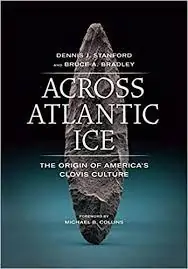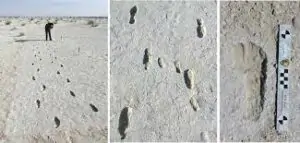Bering Bridge migrations into North America reevaluated with amazing footprints find in White Sands, New Mexico
Carbon dating has been completed on a set of 60 fossilized footprints discovered in the White Sands, New Mexico National Park. Archaeologists and paleontologists are stunned by the dates.
From the Las Cruces Sun News, September 23,
‘Incredible discoveries’: Oldest known human footprints in North America discovered at White Sands
By carbon dating seeds embedded in the footprints, the U.S. Geological Survey estimated the prints were up to 23,000 years old.
The article reports researchers believe humans could have crossed from Asia into the Americas 26,000 to 19,000 years ago, through land connecting what is now Russia and Alaska, during the last ice age. From there, they are thought to have settled a now mostly submerged region called Beringia, but found their way south blocked by glaciers.
As the Las Cruces Sun News, and various other media have reported:
If the dating of the new discovery in New Mexico is correct, it establishes the strongest evidence yet that human beings reached the Americas thousands of years earlier than previously supposed by archaeologists, the paper states, before advancing glaciers closed migration routes from Asia. [Emphasis added]
“Extremely exciting”
More from NPR:
[Mathew] Bennett [Bournemouth Univ. in England] and his colleagues, whose paper was published Thursday, determined that the tracks belonged to numerous people, mostly children and teenagers. What’s more, the footprints spanned a significant time period, suggesting that humans frequented the area for at least a few thousand years.
Tom Higham, an archaeological scientist and radiocarbon-dating expert at the University of Vienna, who was not part of the study, called the latest findings “extremely exciting.”
“I am convinced that these footprints genuinely are of the age claimed,” he said, according to Nature.
Of course, this conflicts with long held beliefs from paleontology, archaeology and anthropology academics who have argued that the first humans in the Americas arrived over the Bering Land Bridge, 14,000 years ago. (Some have stretched that to ~15kya).
More from NPR:
“For decades, archaeologists have debated when people first arrived in the Americas,” says Vance Holliday, a University of Arizona archaeologist and co-author of the latest paper. “Few archaeologists see reliable evidence for sites older than about 16,000 years. Some think the arrival was later, no more than 13,000 years ago by makers of artifacts called Clovis points.”
Alt-anthropologist Steve Sailer wrote (Sept. 27, Vdare) on the new finds:
 it would suggest that somebody got here long before the proto-American Indians of Clovis… Maybe they went more or less extinct? If so, did they die off on their own or did the proto-Indians kill them?
it would suggest that somebody got here long before the proto-American Indians of Clovis… Maybe they went more or less extinct? If so, did they die off on their own or did the proto-Indians kill them?
Famed archaeologist Jennifer Raff of Kansas State University has been a vicious critic of Pre-Clovis theories of settlements in the Americas. The CBC in Canada ran a documentary on Solutrean hypothesis in 2018. It caused a great deal of controversy. Dr. Raff was the leading critic of the series and gained a great deal of international media attention.
In one podcast out of Canada she’s quoted: “The Solutrean hypothesis is not a viable explanation… [the show] was very disappointing.
She even attacked white identitarians for promoting the Solutrean theory.
From The Guardian, 2018,
Rejecting the Solutrean hypothesis: the first peoples in the Americas were not from Europe
The notion that the ancestors of Native Americans were not the first or only people on the continent has great popularity among white nationalists, who see it as a means of denying Native Americans an ancestral claim on their land. Indeed, although this particular iteration is new, the idea behind the Solutrean hypothesis is part of a long tradition of Europeans trying to insert themselves into American prehistory…
Solutreans were a Cro-magnon tribe from southern France/northern Spain. It is theorized the crossed the Atlantic ice bridge on a northern route, some 23 kya. Solutrean hypothesis was the subject of a very well-produced and popular 4-part series by the BBC in 2003, Solutreans are Indigenous Americans” (YouTube).
In brief, Virginiaplaces.org:
 [Smithsonian Inst. curator] Dennis Stanford and [Stone tool-making expert] Bruce Bradley have proposed that people making Solutrean points used boats to move along the edge of the ice sheet during the Last Glacial Maximum, hunting marine mammals and paddling westward until reaching the North American continent. The stone tool found by the Cinmar was a knife lost as some of the first people in Virginia killed and butchered a mastodon trapped in a bog. Both the knife and skull were buried in anaerobic bog sediments and preserved, until being dredged to the surface over 20,000 years later…
[Smithsonian Inst. curator] Dennis Stanford and [Stone tool-making expert] Bruce Bradley have proposed that people making Solutrean points used boats to move along the edge of the ice sheet during the Last Glacial Maximum, hunting marine mammals and paddling westward until reaching the North American continent. The stone tool found by the Cinmar was a knife lost as some of the first people in Virginia killed and butchered a mastodon trapped in a bog. Both the knife and skull were buried in anaerobic bog sediments and preserved, until being dredged to the surface over 20,000 years later…
archeologists have found more sites with Clovis points east of the Mississippi River. The Solutrean Hypothesis assumes arrival from Europe at a pre-Clovis time period, and that later Clovis knappers retained the overshot flaking technique brought across the Atlantic Ocean. The distinctive flute could have been the one design change added by the Clovis knappers.
What may be relevant is that the oldest sites with pre-Clovis technology are on the East Coast. Cactus Hill, for example, was occupied 18,000-20,000 years ago, when the Solutrean points were still being produced in Europe.
Now, with the new dating of the footprints in New Mexico, she’s reevaluating her stance on Pre-Clovis sites. Dr. Raff, doesn’t explicitly say Solutrean sites are valid. But she admits, generally speaking, “pre-Clovis… [now] suddenly more acceptabe.”
So what could explain the presence of people in what’s today called New Mexico (and possibly other places) before the LGM? I see a couple of possible explanations for reconciling the genetic and archaeological records.
— Dr. Jennifer Raff (@JenniferRaff) September 23, 2021
Amateur archaeologist and professional miner and frequent contributor to this site Alan Van Arsdale of Utah, posits an alternative theory, Sept. 27:
The oldest known Solutrean site is 24.5kya. Solutreans were not Europeans, they were mixed European and Native Americans which formed some 500 years after confirmed presence of humans in the Americas.
Steve Sailer wonders along the same lines:
Perhaps the same people kept going back and forth from Siberia to Alaska and occasionally getting past the glacier barrier [but] 10,000 years is a long time to retain genetic continuity in Eurasia…
A few years ago, a curious discovery was made among a few tribes deep in the Amazon: a small percentage of their DNA didn’t look like that of any other Amerindians. The researchers compared it to the DNA of Andaman Islanders in the Indian Ocean. Nobody really has a clue about this finding, but maybe they are descended in slight part from the mysterious White Sands people?



